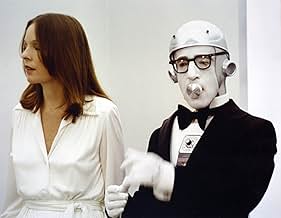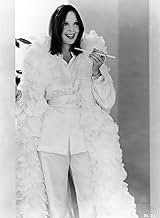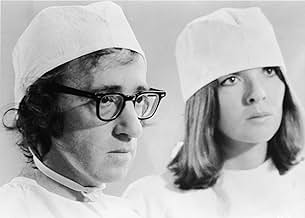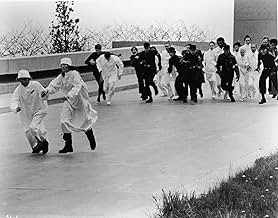IMDb रेटिंग
7.1/10
45 हज़ार
आपकी रेटिंग
एक गंभीर दुकान मालिक, अपनी साधारण ज़िन्दगी से भविष्य की दुनिया में अत्याचारी सरकार से लड़ने के लिए जागृत हो जाता है.एक गंभीर दुकान मालिक, अपनी साधारण ज़िन्दगी से भविष्य की दुनिया में अत्याचारी सरकार से लड़ने के लिए जागृत हो जाता है.एक गंभीर दुकान मालिक, अपनी साधारण ज़िन्दगी से भविष्य की दुनिया में अत्याचारी सरकार से लड़ने के लिए जागृत हो जाता है.
- पुरस्कार
- 2 जीत और कुल 2 नामांकन
Mews Small
- Dr. Nero
- (as Marya Small)
Stanley Ralph Ross
- Sears Swiggles
- (as Stanley Ross)
John Cannon
- Various Voice-Overs
- (वॉइस)
- (बिना क्रेडिट के)
Myron Cohen
- Robot Tailor
- (बिना क्रेडिट के)
कहानी
क्या आपको पता है
- ट्रिवियाWoody Allen originally intended the film to be three hours long and in two parts. The first part would have him in the present day, coping with life until his illness. And the second half would be the futuristic part. But United Artists rejected this concept.
- गूफ़Luna's shoes change from high heels to flats when she crosses the lake on Miles' back (in the "raft" costume).
- भाव
Luna Schlosser: It's hard to believe that you haven't had sex for 200 years.
Miles Monroe: 204, if you count my marriage.
- कनेक्शनEdited into Intimate Portrait: Diane Keaton (2001)
- साउंडट्रैकTill We Meet Again
(1918) (uncredited)
Music by Richard A. Whiting
Lyrics by Ray Egan
Performed by Woody Allen
फीचर्ड रिव्यू
In this early comedy, Woody Allen plays Miles Monroe, a twentieth century healthfood restaurant owner and jazz clarinettist who is cryogenically frozen after surgery and awoken two centuries later. The America of 2173 is a totalitarian state ruled by an oppressive dictator, and Miles has been reanimated by a group of rebels fighting to overthrow the government. For reasons too complex to set out here, Miles is forced to go on the run disguised as a robot and finds himself falling in love with his new owner, an attractive but intellectually vacant young woman named Luna. The film recounts how Miles wins Luna over to the rebel cause and tells the story of their fight against the regime.
Unlike some of Woody's later films, this is a pure comedy. It does not try to explore philosophical issues or to analyse the human condition in the same way as, say, "Hannah and her Sisters" or "Crimes and Misdemeanours". Although I normally think of Woody as a master of verbal wit, much of the humour in "Sleeper" is physical slapstick, based upon (and no doubt deliberate homage to) the comedians of the silent era such as Charlie Chaplin or Buster Keaton. (I particularly liked the scenes where Woody is disguised as a robot and those where the villains are attempting to clone the dictator, killed in a bomb explosion, from his nose). The links with that era are reinforced by the musical score, composed by Woody himself, in a jazz/ragtime style reminiscent of the 1910s and 1920s. The sets, by contrast, are very futuristic, with the clinical glass-and-chromium look of many science-fiction films. The combination of a futuristic theme with a traditional style of comedy is doubtless why the film was advertised under the slogan "Woody Allen takes a nostalgic look at the future".
This is not, however, simply a pastiche of silent humour like the one Mel Brooks was to attempt a few years later in "Silent Movie". This being a Woody Allen film, there is also a good deal of verbal humour, particularly one-liners along the lines of "I haven't seen my analyst in 200 years. He was a strict Freudian. If I'd been going all this time, I'd probably almost be cured by now". (As that line suggests, Miles is the typical, neurotically insecure Woody Allen character). As is often the case with humorous science-fiction (such as Douglas Adams's "Hitchhiker" books), the humour is frequently used to make satirical points about twentieth-century society as seen from the viewpoint of an imagined future. Contemporary worries about our diet are neatly satirised by a joke about how the science of two hundred years hence has proved that fatty foods and smoking are actually beneficial to health whereas what we now think of as healthfoods are regarded as unhealthy. This joke has remained topical because anxiety about what we eat is, if anything,even greater today than it was in 1973. There is perhaps also a dig at seventies "radical chic" as the vacuous conformist Luna becomes an equally vacuous revolutionary. (The plot of "Sleeper" seems to owe something to another tongue-in-cheek science-fiction film from a few years earlier, "Barbarella", which also dealt with rebellion against a dictator and even featured similar "orgasmatron" machines; the star of that film, Jane Fonda, had by 1973 become Hollywood's most famous radical chic actress).
The humour of "Sleeper" is often directed against figures from the sixties and seventies- perhaps too much so, as this type of humour tends to date very quickly. Some of it is still funny (such as Diane Keaton's Marlon Brando impersonation), but some can now be difficult to understand, particularly for non-Americans. (I had no idea, for example, who Howard Cosell was- apparently he was a sports commentator). That is, however, a minor quibble. Overall, this is an entertaining film and, in places, very funny, combining successfully two very different styles of humour. 7/10
Unlike some of Woody's later films, this is a pure comedy. It does not try to explore philosophical issues or to analyse the human condition in the same way as, say, "Hannah and her Sisters" or "Crimes and Misdemeanours". Although I normally think of Woody as a master of verbal wit, much of the humour in "Sleeper" is physical slapstick, based upon (and no doubt deliberate homage to) the comedians of the silent era such as Charlie Chaplin or Buster Keaton. (I particularly liked the scenes where Woody is disguised as a robot and those where the villains are attempting to clone the dictator, killed in a bomb explosion, from his nose). The links with that era are reinforced by the musical score, composed by Woody himself, in a jazz/ragtime style reminiscent of the 1910s and 1920s. The sets, by contrast, are very futuristic, with the clinical glass-and-chromium look of many science-fiction films. The combination of a futuristic theme with a traditional style of comedy is doubtless why the film was advertised under the slogan "Woody Allen takes a nostalgic look at the future".
This is not, however, simply a pastiche of silent humour like the one Mel Brooks was to attempt a few years later in "Silent Movie". This being a Woody Allen film, there is also a good deal of verbal humour, particularly one-liners along the lines of "I haven't seen my analyst in 200 years. He was a strict Freudian. If I'd been going all this time, I'd probably almost be cured by now". (As that line suggests, Miles is the typical, neurotically insecure Woody Allen character). As is often the case with humorous science-fiction (such as Douglas Adams's "Hitchhiker" books), the humour is frequently used to make satirical points about twentieth-century society as seen from the viewpoint of an imagined future. Contemporary worries about our diet are neatly satirised by a joke about how the science of two hundred years hence has proved that fatty foods and smoking are actually beneficial to health whereas what we now think of as healthfoods are regarded as unhealthy. This joke has remained topical because anxiety about what we eat is, if anything,even greater today than it was in 1973. There is perhaps also a dig at seventies "radical chic" as the vacuous conformist Luna becomes an equally vacuous revolutionary. (The plot of "Sleeper" seems to owe something to another tongue-in-cheek science-fiction film from a few years earlier, "Barbarella", which also dealt with rebellion against a dictator and even featured similar "orgasmatron" machines; the star of that film, Jane Fonda, had by 1973 become Hollywood's most famous radical chic actress).
The humour of "Sleeper" is often directed against figures from the sixties and seventies- perhaps too much so, as this type of humour tends to date very quickly. Some of it is still funny (such as Diane Keaton's Marlon Brando impersonation), but some can now be difficult to understand, particularly for non-Americans. (I had no idea, for example, who Howard Cosell was- apparently he was a sports commentator). That is, however, a minor quibble. Overall, this is an entertaining film and, in places, very funny, combining successfully two very different styles of humour. 7/10
- JamesHitchcock
- 27 मार्च 2005
- परमालिंक
टॉप पसंद
रेटिंग देने के लिए साइन-इन करें और वैयक्तिकृत सुझावों के लिए वॉचलिस्ट करें
- How long is Sleeper?Alexa द्वारा संचालित
विवरण
- रिलीज़ की तारीख़
- कंट्री ऑफ़ ओरिजिन
- भाषाएं
- इस रूप में भी जाना जाता है
- Sleeper
- फ़िल्माने की जगहें
- Sculptured House - 24501 Ski Hill Drive, Golden, कालोराडो, संयुक्त राज्य अमेरिका(mushroom shaped building, top of mountain on south side of I-70)
- उत्पादन कंपनियां
- IMDbPro पर और कंपनी क्रेडिट देखें
बॉक्स ऑफ़िस
- बजट
- $20,00,000(अनुमानित)
- US और कनाडा में सकल
- $1,83,44,729
- दुनिया भर में सकल
- $1,83,44,868
इस पेज में योगदान दें
किसी बदलाव का सुझाव दें या अनुपलब्ध कॉन्टेंट जोड़ें























